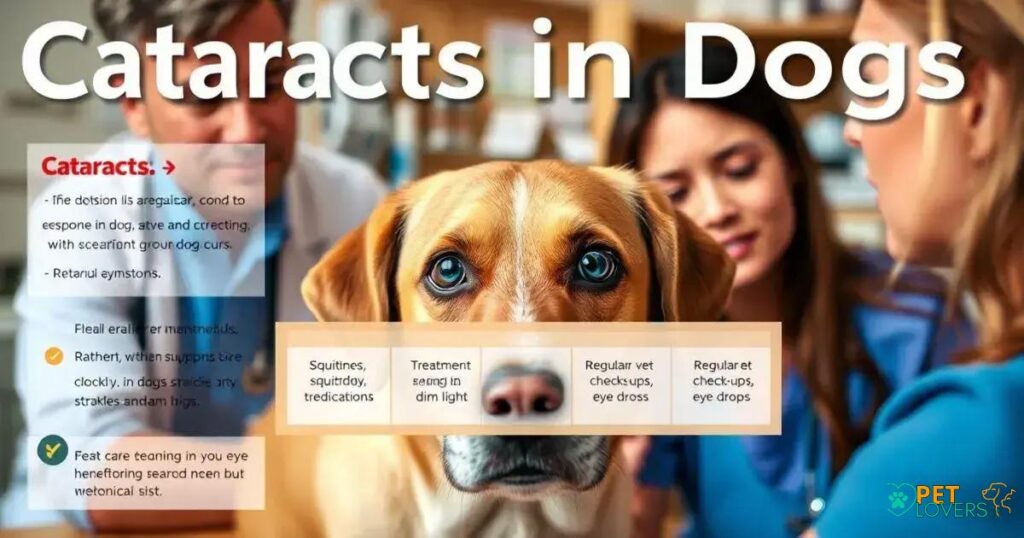Cataracts in dogs are a common issue that can lead to serious vision problems if left untreated.
As a pet owner, it’s essential to recognize the signs and seek prompt veterinary care to ensure your furry friend maintains their quality of life.
In this article, we will delve into what cataracts are, explore the common symptoms to watch out for, and discuss effective treatments and care strategies to help your canine companion.
Understanding Cataracts in Dogs
Cataracts in dogs occur when the lens of the eye becomes cloudy, which can interfere with your dog’s vision. This condition is common in aging dogs but can also arise from genetics, diabetes, or trauma. Understanding cataracts involves knowing how they develop. The lens is primarily made of water and proteins. In healthy eyes, these proteins are perfectly arranged to allow light to enter clearly. When cataracts form, the arrangement is disrupted, leading to cloudy vision.
Some breeds are more prone to developing cataracts, such as Boxers, Cocker Spaniels, and Poodles. Early detection is crucial for effective treatment. Regular check-ups with your veterinarian can help monitor your dog’s eye health through visual exams and specialized tests. The sooner cataracts are diagnosed, the better the chance of successful treatment.
Common Symptoms to Watch For
Recognizing common symptoms of cataracts in dogs is vital for early intervention. One of the first signs pet owners may notice is a change in their dog’s vision. Your dog may appear confused or bump into objects they usually navigate easily. Additionally, you might observe a cloudy or bluish appearance in the eyes. This cloudiness occurs as the lens becomes opaque due to protein changes, making it harder for light to enter the eye.
Other signs include changes in behavior, such as reluctance to play or difficulty navigating stairs. Some dogs may also exhibit signs of discomfort or a tendency to shy away from bright light. It’s important to monitor your dog’s behavior closely and consult your veterinarian if you observe any of these symptoms.
Regular veterinary check-ups will help identify cataracts early. The sooner you recognize the symptoms, the sooner your dog can receive appropriate care and treatment.
Effective Treatments and Care Strategies
Cataracts in dogs are primarily treated with surgery, which involves removing the cloudy lens and possibly placing an artificial lens. Recovery is generally good, and many dogs regain their vision.
A thorough eye examination is essential before considering surgery to assess the dog’s overall health and other conditions that may impact the outcome.
Management if Surgery is Not an Option
If surgery isn’t feasible, management strategies include modifying the dog’s environment to minimize injury risks and creating a safe space for navigation.
Regular follow-up visits are important to monitor eye health and ensure any related health issues are addressed.
Conclusion
Cataracts in dogs need prompt attention to maintain their quality of life.
Regular veterinary check-ups will help in early detection and monitoring of this condition.
Understanding the symptoms, seeking effective treatments like surgery when necessary, and providing proper care can lead to positive outcomes for dogs diagnosed with cataracts.
By being vigilant and proactive about their eye health, you can ensure your furry friend remains happy and healthy.
Frequently Asked Questions about Cataracts in Dogs
What are cataracts in dogs?
Cataracts in dogs occur when the lens of the eye becomes cloudy, affecting vision.
What are the common symptoms of cataracts in dogs?
Symptoms include cloudy eyes, difficulty seeing, confusion, and changes in behavior.
How are cataracts in dogs treated?
Cataracts are primarily treated through surgery to remove the cloudy lens.
Can cataracts in dogs be prevented?
While some cataracts are genetic, regular veterinary check-ups can help identify issues early.
What care strategies should I follow for a dog with cataracts?
Ensure a safe environment, seek veterinary advice, and manage any associated health conditions.
Is surgery safe for dogs with cataracts?
Yes, cataract surgery is generally safe and effective, often leading to a significant improvement in vision.

